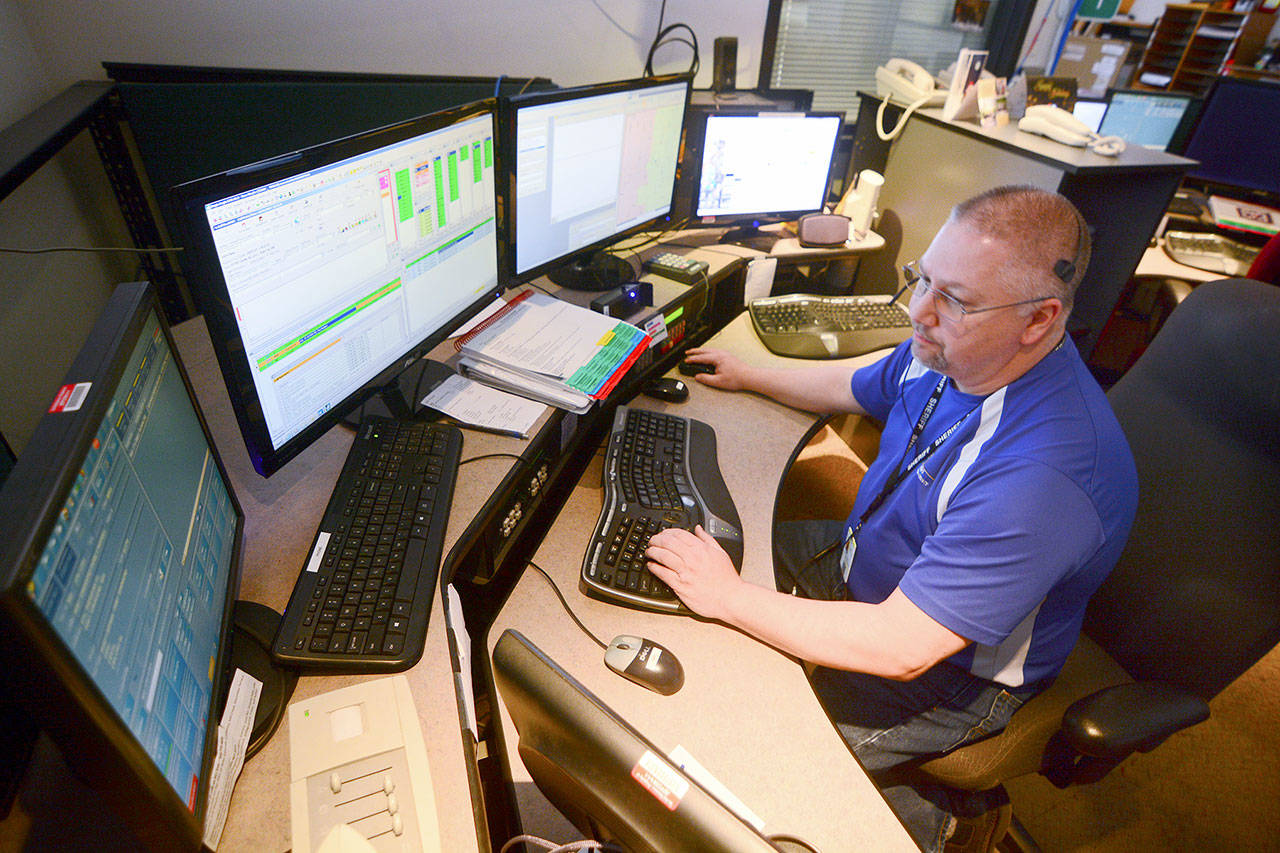There’s a chance that 9-1-1 calls made from cellphones across the North Olympic Peninsula will be routed to the wrong dispatch center, in some cases costing several seconds when seconds matter most.
Every day, calls from Clallam and Jefferson counties are routed to other dispatch centers in the region — including Canada, said Karl Hatton, director of PenCom and JeffCom dispatch centers. Calls from other counties and Canada are also often routed to PenCom and JeffCom.
“Depending on the type of call it can be absolutely critical,” Hatton said. “Seconds save lives.”
Calls in Jefferson County are sometimes routed to either Clallam, Kitsap or Island counties, while calls in Clallam County can be routed to Jefferson or Island counties, he said.
If there’s a clear view of Canada and a cellphone is roaming, there’s a chance the 9-1-1 call will be answered in Victoria. This can be a problem near Hurricane Ridge and along the Port Angeles waterfront, he said.
When Hatton used to work the phones, he remembered getting calls from boaters off the coast of Canada who were often confused when he asked what county they were in.
Calls from Fort Worden and Port Hadlock might first go to Island County while calls along the Hood Canal might end up going to Kitsap County.
Dispatchers can almost instantly transfer people to the correct dispatch center at the push of a single button, but first they need to figure out where the caller is. That can take up to 15 seconds or more, depending on if the caller knows where they are, he said.
“What takes the longest is to figure out where you are at,” Hatton said. “If you don’t know where you are at and we have to play 30 questions to try to figure out where you are at, that’s what takes time.”
Dispatchers in Jefferson County typically receive 60 9-1-1 calls on any given day. At least one of those will have likely been routed to the wrong county initially, he said.
In Clallam, PenCom receives about 95 9-1-1 calls on any given day.
Cellphone towers
Dispatchers can see which tower someone is calling from and can change how they ask for location information if the call is from a tower that frequently sends callers to the wrong county, he said.
The reason calls get routed to the wrong dispatch center is because the signal was picked up by an out-of-county cell tower, he said.
Hatton said this can especially be a problem for Verizon customers in the Port Hadlock area — where the dispatch center is located.
“If I call 9-1-1 on my Verizon phone, about half the time it goes to Island County … and I’m sitting in the office right next to my dispatchers,” Hatton said.
Hatton, also president of the state chapter of the Association of Public-Safety Communications Officials, said the state is working with CenturyLink to track down the root of the problem.
“Their opinion right now — and they are working with Verizon — is that those towers might be reaching capacity,” he said. “When a particular tower is at capacity it is going to send it to the next closest tower.”
Hatton said it’s difficult to tell whether the problem is getting better or worse. As cellphone companies improve their technology more calls are routed to the correct dispatch centers, he said.
But as more people toss their landlines and opt for only having cellphones, that adds to the number of 9-1-1 calls going to the wrong place.
“More and more people have cellphones so the odds of it happening increase, but the phone companies are getting better and better at figuring out your actual location and translating that to 9-1-1,” he said.
It’s not just a regional issue and is a problem that officials across the country are trying to address, he said.
‘Know your location’
Though many phones track location via GPS, Hatton said that information often isn’t provided to dispatchers.
Hatton said that many people believe the area code for their cellphone can affect which dispatch center is called during an emergency, but said that isn’t the case.
“If it’s a United States phone and you call 9-1-1, it’s going to find the closest tower and that’s where your 9-1-1 call is going to be routed to,” he said. “Area codes are meaningless.”
Hatton said it is paramount that people know where they are. Typically people know what county they are in and can be transferred to the correct dispatch, but dispatchers still need to know exactly where to send first responders.
Dispatchers typically only know initially which cellphone tower a caller is calling from, he said. When someone texts 9-1-1, dispatchers don’t have any location data.
“Know your location,” he said. “If you are driving, know where you are at, the nearest milepost or the closest cross street.”
Jesse Major is a reporter with the Olympic Peninsula News Group, which is composed of Sound Publishing newspapers Peninsula Daily News, Sequim Gazette and Forks Forum. He can be reached at 360-452-2345, ext. 56250, or at jmajor@peninsuladailynews.com.



